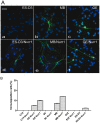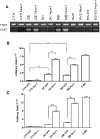Restriction of neural precursor ability to respond to Nurr1 by early regional specification
- PMID: 23240065
- PMCID: PMC3519900
- DOI: 10.1371/journal.pone.0051798
Restriction of neural precursor ability to respond to Nurr1 by early regional specification
Abstract
During neural development, spatially regulated expression of specific transcription factors is crucial for central nervous system (CNS) regionalization, generation of neural precursors (NPs) and subsequent differentiation of specific cell types within defined regions. A critical role in dopaminergic differentiation in the midbrain (MB) has been assigned to the transcription factor Nurr1. Nurr1 controls the expression of key genes involved in dopamine (DA) neurotransmission, e.g. tyrosine hydroxylase (TH) and the DA transporter (DAT), and promotes the dopaminergic phenotype in embryonic stem cells. We investigated whether cells derived from different areas of the mouse CNS could be directed to differentiate into dopaminergic neurons in vitro by forced expression of the transcription factor Nurr1. We show that Nurr1 overexpression can promote dopaminergic cell fate specification only in NPs obtained from E13.5 ganglionic eminence (GE) and MB, but not in NPs isolated from E13.5 cortex (CTX) and spinal cord (SC) or from the adult subventricular zone (SVZ). Confirming previous studies, we also show that Nurr1 overexpression can increase the generation of TH-positive neurons in mouse embryonic stem cells. These data show that Nurr1 ability to induce a dopaminergic phenotype becomes restricted during CNS development and is critically dependent on the region of NPs derivation. Our results suggest that the plasticity of NPs and their ability to activate a dopaminergic differentiation program in response to Nurr1 is regulated during early stages of neurogenesis, possibly through mechanisms controlling CNS regionalization.
Conflict of interest statement
Figures






References
-
- Edlund T, Jessell TM (1999) Progression from extrinsic to intrinsic signaling in cell fate specification: a view from the nervous system. Cell 96: 211–224. - PubMed
-
- Ruiz I, Altaba A (1992) Planar and vertical signals in the induction and patterning of the Xenopus nervous system. Development 115: 67–80. - PubMed
-
- Bertrand N, Castro DS, Guillemot F (2002) Proneural genes and the specification of neural cell types. Nat Rev Neurosci 3: 517–30. - PubMed
Publication types
MeSH terms
Substances
LinkOut - more resources
Full Text Sources
Miscellaneous

